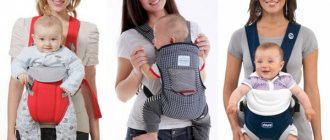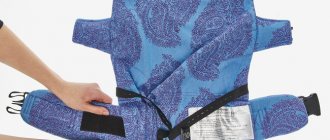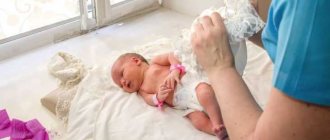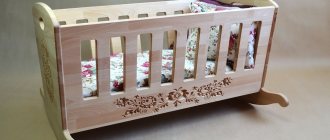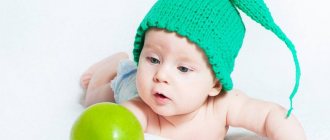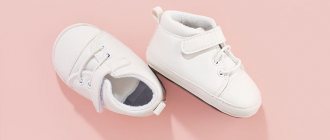The sweet little baby spends so much time in mom or dad's arms! From birth until the age of two, or even longer, children remain “tame.” How to free your hands, not overload your back, and carry your baby comfortably and for health benefits – both for him and the parent? To do this, you need to choose a comfortable device that will help you carry your child on you. In our article we will tell you about different baby carriers: slings, kangaroos and ergo-backpacks.
From what age should I use it?
Kangaroo can be used by parents almost immediately from the moment the child is born. The only and main rule is that for carrying newborns it is necessary to select special models in which the baby can be placed lying down . The newborn should be positioned in front and facing the mother. It is recommended to use such models when the child is in a horizontal position (up to 5 months).
When the baby tries to sit down on his own, and his spine is ready to bear the load and support his own weight, you can move on to kangaroo models with a vertical position of the child.
Most models of kangaroo backpacks are designed for 10-12 kg (the average weight of a child is 9-12 months). However, at this age, children begin to explore the world themselves, taking their first steps, and the need for carrying usually becomes less.
Kangaroo bags are quite simple and easy to use. However, it is important to check the integrity of the fasteners and the reliability of fixation before each use.
Types of carriers
To classify kangaroos, several criteria can be distinguished:
- baby pose - horizontal (for younger babies), vertical, transformer (combines both positions plus lying on its side);
- the position of the child in relation to the adult - facing away from the mother, facing towards the mother, models combining both options;
- a combination of straps on the back of an adult - they are located parallel to each other, cross, connect, and are like a corset;
- for one baby or twins.
How to choose
When choosing a kangaroo, it is important to focus on some points:
- The quality of the material from which the bag is made.
The skin of infants is very sensitive and receptive. In this regard, when choosing a “kenguryatnik”, make sure that it is made of high-quality materials that have passed testing and quality control.
- Reliable fixation.
The safety of the child and the peace of mind of the parents depend on how reliable the fastenings and locks for securing the carrying backpack are. Therefore, pay special attention to the width of the straps, seams, and locks.
- Convenience.
This applies to both mother and baby. For mom, convenience should include quick donning, easy use of such a bag for carrying a toddler, the presence of not only shoulder straps, but also a lumbar belt (this contributes to optimal distribution of the load on the spine and long-term wearing without fatigue).
For a baby, ease of movement in a kangaroo backpack is especially important. If the baby is comfortable, he will be happy to walk in such a bag! Parents must remember that for the child’s convenience, the baby carrier must have sufficient space that will not squeeze the baby and hinder his movements. The back of the backpack should be rigid, with a high headrest. This will provide the newborn with a “place to sleep.” Particularly convenient in such cases are transformable models, in which children can be carried both vertically and horizontally.
- Pay attention to what age manufacturers recommend this or that model.
- The carrier must be able to be adjusted in size.
When buying a kangaroo for a newborn, it is advisable to try it on with your baby. This is the only way to understand whether it is right for you and your child or not. Also pay attention to the presence of additional pockets where you can put the necessary things, a protective hood. It must be possible to adjust the size.
What is the difference?
Each baby carrier is designed for a specific age category. Some of them are designed for children up to 0 to 3 months, while others are from 6 to 10 months. There are also models that “grow” with the baby, that is, they can be used from birth to ten months of age. Such kangaroos, as a rule, have many configurations, which allow them to adapt to each baby.
The simplest backpack, which has few functions and is, in principle, cheap, is the one designed for babies from 0 to 3 months. As a rule, it has only one position and is quite convenient to use, since you only have to adjust it “to suit yourself” once.
The carrier bag for children from 3 months and above already has several positions - “sitting” and “lying down”. Some of them provide for a sitting position only “facing yourself”, which is not very comfortable, since the baby grows very quickly and it becomes interesting for him to look at everything that surrounds him. Based on this, it is best to purchase a kangaroo, which also has the ability to carry the child “facing away from you.” But such models, as a rule, are designed for children 5–6 months old.
Be sure to read the instructions included with the backpack. It describes all the functions that the carrying bag has, as well as the age limit on which the safety of your baby will directly depend.
A very useful and necessary addition for a baby kangaroo is a hood for the child, protecting him from the vagaries of the weather.
Precautionary measures
Keeping your baby in a certain position for a long time and limiting his movements can lead to blood stagnation and rapid fatigue. To avoid this, it is recommended to use the kangaroo for no more than 1-2 hours . Every 20-30 minutes it is advisable to take a break and remove the newborn from the bag. This will allow both the child and the mother to rest.
The baby's legs and arms should remain free. A wide seating area helps spread the child’s legs and provides additional prevention of dysplasia.
Parents should also pay attention to ensure that the straps and other parts of the bag do not rub the child’s skin, and that the headrest securely fixes his head.
You should not use baby kangaroos when cooking, being near a hot stove, or eating.
When carrying a child using a baby carrier, a young mother should be especially careful and attentive, because such a device somewhat blocks the view.
Watch the video:
How to carry a baby forward-facing in a baby carrier:
Sling or kangaroo
A baby sling is considered an excellent alternative to a kangaroo carrier, especially for carrying babies under 6 months of age. In a sling, the baby's position is as close as possible to the physiological position in the mother's arms.
Slings are simple and easy to use and do not take up much space. The baby is especially comfortable in a soft sling that does not hinder his movements.
However, when the child grows up, and his manipulations with objects and his own actions expand significantly, it is better to purchase a kangaroo backpack, which has much more possibilities for carrying the baby. So, in baby kangaroos you can carry a child in several ways: in front, facing the mother or away from the mother, and also from behind.
Experts' opinions
Pediatricians, orthopedists and other pediatric doctors are quite skeptical about this invention, citing its harmfulness. They stipulate this by the fact that up to 6 months the baby should be in a free position and not experience stress on the spine and pelvic area. In the case of using a “kenguryatnik” such a load takes place. However, at the age of 5-6 months, when the baby makes attempts to sit independently, the use of such devices is allowed. Until this age, it is better to use models with a horizontal position or a sling.
See articles about slings:
Types of slings, how to choose and how to wear a sling, read in this publication -
You don’t have to buy a sling; you can make it yourself.
See video: Sling scarf, Kangaroo wrap
Thus, for newborn babies, a kangaroo carrier bag is a great option for modern parents! These inventions will allow young mothers to go shopping, go to the library, and go on a visit without any problems. And at the same time, the “valuable cargo” is always nearby and safe! The only thing that needs to be taken into account is that it is advisable to use kangaroo backpacks no more than 1-2 hours a day.
Read more: choosing a stroller for a child
More videos:
Kangaroo is a special device in the form of a carrying bag for carrying a small child, which is attached to the belt and shoulders of an adult. The baby is placed inside in a lying, reclining or sitting position and secured inside the bag using special straps. This way, the adult’s hands remain free.
Mom or dad can go about their business, while the baby will always be nearby and under supervision. A kangaroo allows you to move comfortably with your child, go to the clinic, go shopping and even travel. In this article we will learn how to choose a kangaroo for a child. Let's look at how to use this device correctly and for how many months.
Are kangaroos harmful?
Doctors, including Dr. Komarovsky, express a categorical ban on transferring children to kangaroos until they learn to sit on their own. This, of course, applies to seated forms of carrying. In this position, the entire weight of the child presses on the perineal area and the entire load goes on the spine. This puts the spine at risk and can also lead to the development of dysplasia in absolutely healthy babies (we recommend reading: what is hip dysplasia in newborns and how is it treated?). In other words, such a method of traveling with a small person will be very harmful.
The kangaroo carrier does not have wide shoulder straps, a waist belt or tension straps. This design does not allow the baby to be pressed as closely as possible to the mother. The center of gravity is shifted forward, which provokes in an adult the need to bend, and this is fraught with back pain.
A kangaroo backpack cannot give a physiological shape to the spine. The baby's legs dangle, and this can cause improper formation of the hip joints.
The correct fit for a 4 month old baby in a backpack should resemble the letter “M”. A little later, when the baby masters sitting independently, the position should resemble the letter “P”.
Such positions are only possible when using an ergonomic backpack or, in other words, a sling backpack. You can watch a video on the Internet to see how to put a baby in a backpack.
READ ALSO: how to teach a child to sit independently: video
The angle of spread of the legs should be 90-110 degrees relative to the vertical position of the body. This angle guarantees correct fit, which means it will protect the hip joints from improper development and will not allow displacement of the vertebrae. Not a single model of kangaroo pouch is able to provide a physiological fit for the baby. Until the baby sits on his own, it is too early to think about buying a kangaroo pouch.
Pros and cons of using a kangaroo
The main advantage of such a device is that mom or dad can go about their business while the baby is nearby and under supervision. In addition, when walking or going outside, you will not have to lower and lift a heavy stroller up the stairs. In addition, the child constantly feels the closeness of his parents, which has a positive effect on the mental and emotional development of the baby.
In a kangaroo, the child falls asleep well and quickly, feels comfortable and protected. But such a device also has its disadvantages. First of all, this is a big load on the mother’s back. A kangaroo will be safe for a newborn if you choose the right model and use the product correctly.
It is important to know that there are some age restrictions when using this type of carrier. Thus, classic models cannot be taken for children under 5-6 months. Let's take a closer look at how many months you can carry a baby in a kangaroo.
Advantages
A kangaroo is a special device for carrying babies comfortably. It is secured to the belt and shoulders using highly secure fastenings. The child is placed inside the carrier sitting or lying down - it depends on the age of the baby. It is then securely secured with a belt.
Kangaroo is an indispensable accessory because:
- In kangaroo care for newborns, the baby is always nearby;
- the mother can go about her business while in contact with the child, because her hands are free;
- walks become much easier, because you don’t need to carry a heavy stroller down the stairs and push it on the street;
- The baby is always calm, because his mother is nearby. In addition, when moving, he will fall asleep faster;
- Compared to the prices of strollers, a baby carrier is a fairly economical device.
At what age are kangaroos used?
A standard sit-only baby carrier should not be used for babies under four to seven months of age. Until the baby begins to sit down and sit independently, the baby should not be placed in an upright position. At this age, the baby’s spine and back muscles are not yet ready for such loads and cannot support the child’s weight.
For a newborn and a child from 0 to 6 months, choose models that can support a horizontal position. As soon as the baby learns to sit on his own and hold his head up, they switch to models with a sitting or upright position.
The classic kangaroo carrier is designed for a child older than six months with a body weight of 10-12 kg. This model is used for a baby who already confidently holds his head and sits independently. In this case, the weight of infants must be at least 7.5 kg. At what age can a baby be seated, and when does he begin to sit on his own, read here.
In addition, there are special models for children almost from the first days of life. They represent a carrier with a rigid liner and a headrest for horizontal carrying of the baby. This backpack allows you to press the baby tightly against the mother’s body, and it is absolutely safe for a fragile spine. This carrier can accommodate a newborn and a baby up to four to six months.
You can also purchase a multifunctional model that can be converted from a lying mode to a vertical one. This bag can be fixed on its side and the baby can be placed lying down or reclining, which allows you to comfortably breastfeed the baby. At the same time, you can move the backpack and switch from one mode to another without removing the baby from the carrier.
Safety for boys and girls
Questions about how safe baby carriers are can generate a lot of debate. Orthopedists and pediatricians agree that kangaroo restraint is not anatomically correct, however, if the child is already sitting independently and spends a reasonable amount of time in it, there will be no harm to health.
As for the gender of the possible passenger, there is not much difference. The only thing you should pay attention to is the recommendation that when girls sit down early, due to excessive load on the spine, deformation of the pelvic bones can occur, and this can lead to problems in the future during childbirth. Therefore, carrying young princesses in an upright position is more dangerous than boys.
If you limit wearing time to one, maximum three, hours a day, then it is not harmful from the age of two months. Try to choose a baby carrier model so that the baby does not just hang in it, leaning on the crotch, but presses more or less tightly against the mother’s body. This makes it possible to significantly reduce the vertical load on the spine.
How to choose a kangaroo
- Choose a kangaroo for newborns with an orthopedic back and head support. The model must necessarily include a mode in which the baby can be laid down and secured in a horizontal position;
- Choose models with a hard back, high headrest and wide seat. They are the most comfortable and can provide a comfortable place to sleep;
- The most convenient are transformable kangaroos, which can be fixed in both horizontal and vertical positions;
- Choose sitting models for a child who already knows how to sit confidently and hold his head up;
- Choose high-quality and durable, natural and hypoallergenic material that will allow your baby’s skin to breathe and will not create a greenhouse effect, which can lead to skin rashes and cause severe diaper rash in the baby. Do not choose foam rubber and synthetic fabrics!;
- The material in the area where the legs are fixed should be soft and comfortable and should not rub the skin;
- Products must have high-quality and durable, neatly stitched and non-protruding seams that will not interfere with the child;
- Choose durable belts with secure fit and fastening. Check the width of the straps, the comfort of the seams and locks. The most convenient to use will be models with a belt that is fixed on the belt, and not just on the shoulders of an adult. This will reduce the load on the back and spine;
- Choose a kangaroo that can be put on or taken off easily and quickly;
- “Try on” a kangaroo for your child. There should be enough space inside for the baby to feel free and comfortable. The carrier should not hinder movement and squeeze the baby’s body;
- When choosing, pay attention to the age and weight of the baby the carrier is designed for. The product must be able to adjust its dimensions;
- The most convenient, comfortable and functional carriers are those with additional pockets, a protective hood and a bib;
- Choose models that have been tested and received a quality certificate. Read reviews from parents and see the ratings of the best manufacturers.
Ergo backpack
It is important to remember : an ergonomic backpack is not a kangaroo at all! Yes, it also has straps, but in design and meaning it is identical to the May Sling. This means it has all the advantages of May: it allows you to carry the baby in the correct physiological position and well distributes the load over the back, shoulders and hips of the parent. The difference is that instead of long straps that need to be wrapped around itself and tied in a knot, the backpack is equipped with fastex latches and volume regulators. It looks more technologically advanced and fashionable, which is why many dads look at it favorably.
The ergo-backpack is based on a reinforced strap-belt that fastens at the waist or hips (the volume is adjustable). On this belt there is a rectangular or trapezoidal panel that supports the child under the back. Reinforced straps are attached to the corners and sides of the rectangle; mom throws them over her shoulders (the volume of the straps is also adjustable). These straps are fastened together behind the back or on the chest using a special fastener.
Pros. The ergo-backpack is put on almost instantly and is very simple; you can put your baby in it very quickly. He looks stylish. As a rule, the backpack is equipped with a spacious pocket and a hood-holder: with its help you can support the head of a sleeping baby. Transferring the sleepyhead from the ergo-backpack to the crib without waking her up is easy and simple. The child can be carried in front, on the back and on the hip, facing towards you or away from you. The backpack relieves the parent's back well, although it is inferior in this regard to the May-sling and, even more so, the scarf-sling.
Minuses. As in a May-sling, a newborn can only be carried in an ergo-backpack in the “feet-in” position. In this case, you need to make sure that the baby is tightly pulled to the parent. But most often, babies are carried in a backpack from 4–6 months. The backpack does not have a horizontal sleeping position.
What to pay attention to. The volume of the base belt should suit your size - especially if you have very small or, conversely, large hips (check this point with the seller). Fastex fasteners must be securely fastened. The straps that allow you to adjust the volume of the belt and straps should not be slippery so that the backpack does not become loose when walking. High-quality backpacks are usually equipped with a hood and headrest. The hood is not needed during wakefulness, but during sleep it supports the baby's head and protects from the sun. The hood should be easily and securely attached to the backpack straps. And one more interesting point: some manufacturers offer ergo-backpacks with a special soft insert, which allows you to carry babies in them comfortably and safely.
, “I Love Mum”, “Pognae”, “Amaeru”, “Miracle Child”, “Baby Bjorn”.
The best kangaroos for a child
| Brand | For whom | Advantages | average price |
| Cybex First.Go | Children from birth to three years (3.5-18 kg) | Can be worn in four positions, the backpack can be adjusted according to the child’s height, there is a removable insert for a newborn, natural and durable materials | 6000 rubles |
| Cybex 2.GO | For children over three months | An improved model with adjustable straps and sizes, a hood, safe and durable materials | 6000 rubles |
| Manduca Baby Carrier | Children from the first days of life to three years (3-20 kg) | Three wearing positions, special insert for newborns, 100% natural and pleasant to the touch fabrics, wear-resistant and hypoallergenic, light weight and compact size | 8000 rubles |
| Chicco Go Baby | Allowed for children from birth to 1.5-2 years, but not recommended for newborns and babies under 6 months (up to 9 kg) | Classic model with two wearing positions, affordable price, durable material and fittings, correct and strong stitching, rigid back and bib included | 1500 rubles |
| Baby Bjorn Original | For children from birth to 1.5-2 years (3.5-12 kg) | High quality, safety and hypoallergenic, made of 100% cotton, adjustable foot position, additional pillows and pads | 6000 rubles |
| Baby Bjorn Active | For active parents, children over 1 week up to 1.5-2 years (3.5-12 kg) | Allows you to walk and travel for a long time with your child, the presence of additional belts for fixing the head of a newborn, safety and high quality of the model | 8000 rubles |
| GLOBEX Koala | For children over 3 months (3-10 kg) | Anatomical and practical model, adjustable straps and sizes, rigid back, availability and low price | 800 rubles |
How to wear a kangaroo
After you have chosen and purchased the appropriate model, it is important to figure out how to properly carry your baby in a kangaroo. They are easy to use and can be attached to the shoulders and waist of an adult. Classic models allow you to carry the baby with his face and back to mom or dad and behind an adult.
When putting on a kangaroo, be sure to check the integrity of the fastening and the reliability of the fixation. The arms and legs of infants should remain free. It is recommended to sit the newborn facing the mother, since in this position the baby feels more comfortable and can sleep. The child must be fixed with the letter “M” and not “P”!
The first application of kangaroo should not last longer than ten minutes. Gradually increase the time, but do not use the device for more than two hours. Moreover, it is advisable to take a break every half hour and remove the baby from the bag. Make sure that straps and straps do not rub your baby's skin.
Wear the baby carrier in a way that does not block your view, especially if you are carrying your baby upright. To ensure safety, do not use the device while cooking, near a hot stove or open fire, when eating, or move the baby carrier behind your back.
Nuances of choice
Every mother is interested in choosing a high-quality and comfortable product. Expert advice will help you cope with the task:
- You need to choose a baby carrier for newborns from soft, dense fabric with a water-repellent effect that does not cause allergies. Depending on the season, the structure can be insulated or made of lighter materials.
- All fixing devices must be reliable. You should not buy models with unsafe locks (Velcro, buttons). The correct location of the clamps is on the side to eliminate the possibility of injury to the child.
- The comfortable length of the belts is 8 meters. To prevent the baby's weight from causing inconvenience to the mother, the carrying bag should have a belt.
- A kangaroo with a wide seat is preferable (it should be at least 16 centimeters).
- During the fitting process, it is important to monitor the position of the baby so that the straps and straps do not put pressure on his body. High-quality models must have headrests for fixation.
- It is better to prefer a kangaroo with the ability to adjust the elements.
When choosing a model, you should be guided by simplicity and ease of use. Extra details will interfere with everyday life.
Good material and components
The basis of the kangaroo is fabric. It must be:
- Natural. At least the inner layer. It is better that the entire carrier is made of environmentally friendly material.
- Don't shed. If the paint is washed off from the fabric when washed, this means that in order to reduce the cost of production, this process was simplified and cheaper materials were used.
- The seams must be strong and durable. They have to withstand the load of the child's weight.
The fittings should also be durable, without peeling paint. It is preferable to use metal fasteners and zippers. In second place is a tree. Plastic is best avoided.
The metal can also be different. Snaps are less durable than carabiners, so keep that in mind. Also, a transformable backpack for newborns from 0 should not have a cardboard bottom insert.
Functionality
The more functions this item has, the longer it will last. Therefore, it is necessary to balance expectations and purchasing possibilities. If you plan to wear a baby carrier only at 7-8 months of life, then there is no point in choosing a transformer from birth and vice versa.
Convenience and ease of use
It is important to consider how the backpack is fastened. The better it is thought out, the more valuable it is. You can buy the first one you come across, regardless of convenience. Then you will almost certainly have to face the fact that putting it on will be long and difficult.
Note! Most often, the mother has to put on, fasten the backpack, and put the baby in it herself. Therefore, when purchasing, you should definitely check whether it can handle this.
An example of a well-thought-out kangaroo pouch
Easy to care for
There are no clear restrictions on the choice of fabric, except naturalness. You can choose a kangaroo with a top layer of expensive silk, all at the discretion of the parents. But this will be impractical - such fabric requires special care. Therefore, it is better to choose a carrier based on the following criteria:
- Thick fabric. It is less subject to wear and easily tolerates washing. There are no clues on it. For example, linen will do.
- It is ideal if there is a special impregnation of the fabric - waterproof, for example.
We recommend reading: Do you need a high chair to feed your baby? TOP 10 best high chairs
Sling or kangaroo
Not every doctor approves of the use of a kangaroo for babies, and this device is recommended for children older than four to five months, even if the model is intended for a newborn. A sling is a suitable replacement for a kangaroo for babies up to six months old. These are safe and comfortable devices to use, the design of which is as close as possible to the physiological position in the mother’s arms.
At the same time, the sling also frees up your hands. It is made of soft and comfortable fabrics, securely fixes the baby and does not hinder the child’s movements. The sling provides a comfortable and correct positioning of the legs, therefore it is more suitable for the baby in the first weeks of life. However, some models cannot be used for children older than three months.
What is better to choose, a sling or a kangaroo, depends on the age and developmental characteristics of the baby, and the preferences of the parents. How to choose and use a sling for a newborn correctly, read the link
The birth of a baby is the greatest joy in every person’s life. Many young parents want to carry their child in their arms all the time, but over time the baby grows and becomes heavier. And sometimes only dads can carry a grown child in their arms. Therefore, there is a need to purchase a kangaroo for children. At what age can it be used? This is usually written in the instructions (depending on the model).
Experts' opinions
Orthopedists, pediatricians and other specialists believe that long-term stay in a kangaroo can be harmful for babies under 6 months; they only allow a free position to avoid stress on the child’s skeleton. However, experts do not see any contraindications for carrying children who have already begun to sit up on their own in a bag.
Mobility and free hands are what any young mother with a newborn baby lacks. From the first days of life, a baby needs close tactile contact with his mother, but constantly carrying him in her arms can be physically difficult. To make carrying a child easier, there are several types of carriers, which are divided into three groups:
- Physiological - various types of slings, ergo-backpack and hipsit;
- Non-physiological - kangaroos.
- Life-threatening babies are pseudoslings.
Many of these types of carriers look very similar to each other. This external similarity and laudatory description of each manufacturer of their product puts inexperienced young mothers in a rather difficult position. How to choose the right and comfortable baby carrier? To answer this question, let's take a closer look at each type.
Pseudo-sling is a carrier bag and “Infantino”. The design of these devices does not allow the baby to be in a natural position, strongly pressing his chin to the chest and making it difficult for him to breathe.
The thick sides and lacing of the bag do not provide the ability to adjust the tension of the fabric on the back of the child. The use of pseudoslings in the United States led to the death of several infants, after which they were banned from sale.
Ways to carry a baby
A kangaroo pouch for a child is the most popular today. However, recently it has begun to give way to another type of carrier - a sling. Although slings are not considered a new product, many still do not know what the difference is between these two ways of carrying toddlers.
A kangaroo pouch is a case for a baby that primarily secures the baby's back, while the legs hang down. In this case, the child can be carried with his face or back towards you. A sling is a dense fabric carrier that preserves the physiological position of the baby’s body. You should remember that there is a limited period of time when you can use a kangaroo for children. At what age should it be used so that the child can feel comfortable there? As a rule, this is from about 4 months to a year, since these carriers can support a child’s weight of no more than 10-12 kg.
Contraindications
Despite the undeniable benefits of the kangaroo method, it is not permissible to use it in every case. The attending physician evaluates in a comprehensive manner how ready a newborn is for such contact: some weakened babies are extremely dangerous to remove from the incubator, so interaction with parents should be postponed. In addition, you should not continue contact using the kangaroo method if the baby’s condition worsens during or after skin-to-skin contact - this will be indicated by the readings of the heartbeat and breathing sensors. You should not take such a prohibition as an immutable credo - after some time, the newborn’s condition may stabilize, he will get stronger, and the doctor will change the decision in favor of joint nursing with his parents.
In addition, there are a number of medical contraindications that prohibit such events. These include:
- an infectious disease of a child characterized by an extremely severe course;
- intraventricular hemorrhage in a baby;
- the presence of difficult to install and poorly fixed catheters;
- any disease of viral or bacterial etiology in the parents, which can be transmitted to an already weakened baby.
In any case, the question of the possibility of physical contact using the kangaroo method should be decided individually together with the neonatologist who is caring for the little patient - only he can assess the degree of risk and predict how safe it is for the baby to leave the incubator.
Comparison of sling and kangaroo
Comparing the two types of carriers, it should be noted that the sling has more advantages than the kangaroo for children. At what age can you carry a baby in a sling? This is a relevant question for mothers. The answer is simple: from the moment of birth. Even in ancient times, many carried their children in a scarf, which pressed the baby tightly to the mother. This carrier completely frees not only the mother’s hands, but also her movements. The child is in a physiological position.
There is no space between the child and mother. In addition, there are no problems with feeding the baby in a crowded place. In a comfortable sling, strangers will not see anything. Mom can adjust the length of the sling without outside help. A kangaroo bag for children does not have this advantage. Reviews about this method of carrying a child are mixed. Some people like it, others prefer a sling.
Recommendations for choosing a kangaroo
To be fair, it is worth noting that among carriers of this type there are many good models that will be comfortable for both mother and baby. Those who decide to purchase a kangaroo should follow a few simple recommendations.
A quality kangaroo pouch has:
- wide straps that will be comfortable for carrying a child for a long time;
- reliable fastenings, the best fastening option is carabiners;
- a belt in the waist area that will relieve the load from the spine;
- the maximum weight for which carrying is designed is no more than 10-12 kg;
- rigid built-in back;
- large adjustment range;
- headrest that provides support for the baby's head;
- bib that can be removed.
The inner layer of the bag is of no small importance. It must be made from natural fabrics. There are also carriers that can be used for babies under 4 months. These models have a special horizontal insert. It is worth taking seriously the choice of kangaroo for children. At what age to use, each parent decides independently.
